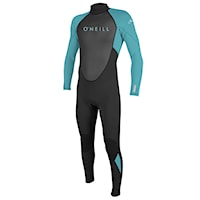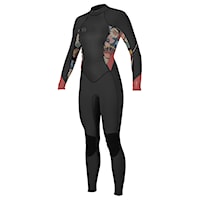A Journey to Perfection of the O'Neill Wetsuits
4th April 2022 | 0 comments
Read the story of how Jack O'Neill changed the world of water sports forever with his invention of the wetsuit. O'Neill wetsuits are still one of the industry's leading wetsuits today!
„I just wanted to surf longer.”
The quote by Jack O'Neill, the inventor of the so-called wetsuits, or surfing suits, accurately reflects his original motivation: keep himself warm for a longer time while surfing and create something to be able to surf all year round. At that time, he had no idea that he was starting to make the history of the company, which became one of the most important wetsuits producers in the course of fifty years and turned into the leader in the world market.
From a leisure activity to regular work

The new phenomenon called surfing was born in 1952 on the coast of California. Even though born in Denver, Colorado, Jack O'Neill loved the ocean all his life and that's why he moved to the Southern California with his family, where he lives up to this day. Before he started his surfing business, he worked as a lumberjack, served in the army, and worked as a constructor. However, the work was not fulfilling enough, and on every possible occasion he tried to escape to the ocean.

„One afternoon after my surfing break I was leaning over a drafting table with one of my architect clients and all that water in my sinuses poured out all over the set of original drawings we were examining.”
He immediately succumbed to the surfing passion. And the passion for the sport was what led him to open his own Surf Shop in a garage on the Santa Cruz Coast. Their shop became a place for frequent meetings of people and the number of surfers in the neighborhood started to rise rapidly. The beach shop was blooming and soon it was time to move the place to the 41st Avenue. This place offered large premises for the factory and the opportunity to employ all six of Jack's children. Mike helped dad with the design, Kathy was in charge of accounting, Pat organized the O'Neill team, Bridget moved to the new sportswear division, Shawn tested the products, and Tim was in charge of promotion.

The first attempts at "wetsuits" were quite crazy. At the beginning, they stuffed bathing suits with PVC, which had good insulation properties, but it was very difficult to work with. Soon, however, they made great progress by discovering a neoprene foam sample. Neoprene was already a really good insulator back then, so Jack could start producing neoprene suits. He designed a short suit "John" for spring surfing and "Long John" for cold weather.
Even with the use of a better material, however, there is no comparison with today's modern wetsuits. The ones from the fifties were still very stiff and often uncomfortable on the body. They were made without lining or any other base material. What's more, the problem of unreinforced neoprene was its fragility and stickiness. Therefore, every surfer had to use powder to get into it.

Two-piece Diving Suit (1952): Jack also experimented with a two-piece diving suit from army surpluses. It was made of rubber, without thermal insulation, so he wore clothing under it. The top and bottom of the suit were only rolled up in the waist. In the turbulent surf, the connection often did not withstand, and the water quickly drifted into the legs and sleeves. And then it started to be dangerous.
PVC Foam Vest (1953): The prototype of the waistcoat was made of remnants of PVC foam. It lacked the tensile strength, so Jack covered it with a transparent plastic foil. The water then dripped off the waistcoat much faster and the process of evaporation and cooling of the body was slower.
Beavertail Jacket (1955): The jacket was followed by "the vest", which was fastened between the legs and, in addition to thermal comfort in delicate parts, helped to keep shorts in their place.

Shaped Seams and Zigzag Stitches (1964): Jack O'Neill shaped the cut so that the stitches wouldn't tear when the neoprene is stretched. At that time, the wetsuit was stiff enough and the zigzag stitches greatly increased the flexibility of the suit at key seams. In addition to that, the wetsuits were also noticeably upgraded design-wise.
New cuts (1964): New cuts of wetsuits - the so-called Short John, Long John, Farmer John - and the vest in addition to that meant a pretty diverse choice for surfing for any time of year.
Rolled edges (1965): O'Neill introduced inward curved edges of wetsuits. This significantly reduced the absorption of neoprene and increased the thermal comfort.
Colors! (1968): O'Neill wetsuits were already available also in color.
Step by step towards the perfection

The invention of nylon became the perfect solution for the wetsuit's base layer. It is still used these days, but its properties are incomparably better. The first nylon materials were not flexible so the wetsuit was relatively stiff. In 1970, a double-sided lined neoprene wetsuit was protected by elastic nylon. The neoprene's resistance had thus greatly increased, and it was possible to dye the outer nylon layer to create colorful wetsuits.

The first neoprene stitching was very simple: two pieces of material were stitched together with mere overlapping of the edges. The process was simple, but not very effective. Punching brought many problems. That's why Jack had to look for another way to combine the neoprene parts. The so called taping seemed like a possible solution. The seams were sealed with a strip of nylon that sealed them and didn't let the water in. The tapes were sealed in neoprene on the outside. Soon came the time of colored suits, so the seams had to be moved on the inside to hide them.

O'Neill Reactor II BZ 3/2 Full
99.95 €

O'Neill Wms Reactor II Back Zip 3/2 Full
120.00 €

O'Neill Youth Reactor II Back Zip 3/2 Full
90.00 €

O'Neill Hammer Cz 3/2 Full
190.00 €

O'Neill Wms Bahia 3/2 BZ Full
95.90 € 159.95 €

O'Neill Toddler Reactor Boys II 2 mm Back Zip Full
60.00 €

Another idea was to glue the neoprene ends together instead of stapling them. This way of joining the materials together stopped all water penetration and the seam was kept flat and smooth. The disadvantage was that the neoprene/glue/neoprene combination was not strong enough and there was danger of the material being torn apart. Fortunately, the Blindstitch revolution came. A blind stitch that cannot be seen is much more comfortable than any of the existing alternatives, and also the strongest of all of them. The curved needle used for the blind stitch is designed to pass the material just below the surface and return to the same side. Neoprene is stapled without punching, which means: no holes → no water.

Nowadays, the Blind stitch is the primary method for stitching neoprene suits, especially models suitable for colder conditions. In 1971, an accident happened to Jack when surfing. He became one of the earliest victims of surfing using a belay cord, the so-called. leash. The surfboard attached to his leg snapped off and hit his face in such an unfortnate way that Jack lost his eye. Ironically, leash was invented a year earlier by Pat O'Neill, a son of Jack.
Supersuit (1970): In addition to surfing, Jack also had another passion - flying with a hot-air balloon. And because he often ended up on the surface of the ocean with a balloon, he began to develop a rescue supersuit. It was inflatable and equipped with an airtight zipper. The so called Supersuit then saved many lives.
Animal skin (1970): Neoprene with strategically placed ergonomic panels of various thicknesses for durability and thermal comfort. The Suit with super resistant back zipper.

„It's Always Summer on the Inside.“
Bearded O'Neill, styled as a pirate with an eye patch, was later used in a corporate logo all-around the world. Thanks to its success, the O'Neill Surf Shop turned into a thriving company in 1980, with its products literally dominating the market and becoming a leader in sports equipment. In 1985, Jack decided to hand over the position of Chief Executive Officer to his son Pat, and he himself remained the head of the board of directors. Handing the company into good hands, Jack got back his time for surfing and other projects. Because he himself was dyslexic, he became the patron of the school for children with this learning disorder. At the same time, he was actively working to save the White Shark from extinction and devised the O'Neill Sea Odyssey program, where children learn about the reality of life and the threats to the oceans.
"The ocean really gives us a lot, in many ways. For many years, it has been a vital part of my life and it brings me inner peace. When everything is wrong, all you have to do is jump into the water and all worries seem to have disappeared."

Jack always kept in touch with his business and entertained foreign visitors, while his collection of awards was growing. Introduced in the International Surfer's Hall of Fame (1991), in 1999 he was named one of the 25 most influential surfers of the century by the Surfer magazine, and in 2000, Industry Manufacturers Surf proclaimed him SIMA’s Waterman. He loved surfing, and once in a while he would fly in his hot-air balloon over the bay. His son, Tim, went on these adventurous trips with him - sitting in an escort boat and always ready on the landing place to make sure the man who invented the neoprene suit was alright.

Before Jack appeared, surfing in the cold waters was a harsh sport that only real madmen were doing. With this "rubber baron" it is possible to do water sports anywhere in the world and throughout the year. O'Neill products are constantly innovated and the perfect choice for all water-sports lovers.



























